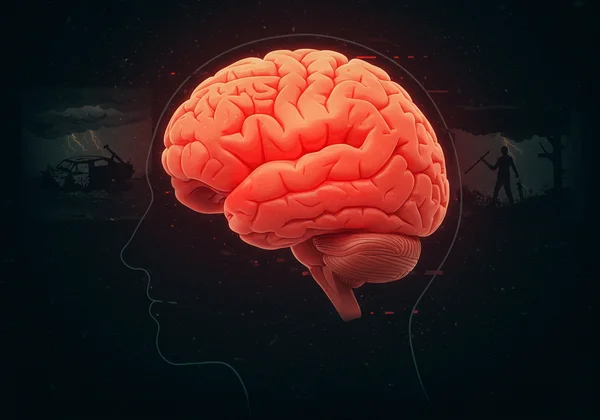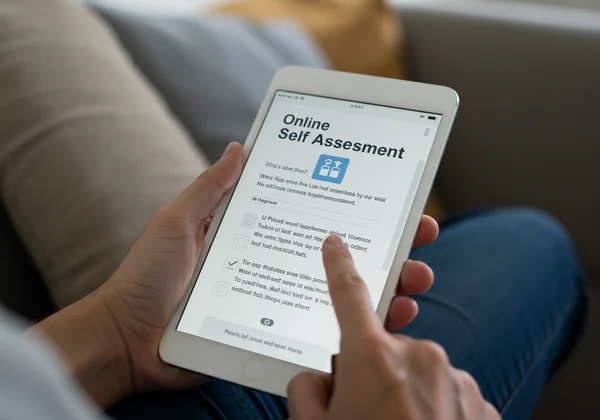PTSD vs. Anxiety Test: Know the Key Differences
Feeling overwhelmed, constantly on edge, or haunted by past events? It’s a heavy burden to carry, and the confusion of not knowing what’s happening can make it even heavier. Many people find themselves caught in a storm of emotions, wondering, do I have ptsd or anxiety? The symptoms can feel similar, but their roots and pathways to healing are distinctly different. This guide is here to offer the clarity you deserve, helping you understand the crucial distinctions between these two conditions.
Understanding what you're experiencing is the most powerful first step toward regaining control. While this article provides valuable information, a personalized assessment can offer deeper insight. A confidential PTSD test can help you privately explore your symptoms and find a starting point for your journey. If you're ready to understand more, you can take our free test at any time.

Understanding PTSD: Beyond General Stress
Post-Traumatic Stress Disorder (PTSD) is more than just feeling stressed or sad after a difficult experience. It is a specific mental health condition that can develop after a person is exposed to a traumatic event. This experience is the anchor point from which all symptoms of PTSD extend, making it fundamentally different from generalized anxiety.
What is PTSD and What Causes It?
At its core, PTSD is a reaction to experiencing or witnessing a terrifying event, such as a serious accident, combat, natural disaster, or physical or sexual assault. According to the American Psychiatric Association, the condition doesn't just stem from any stressful life event but from exposure to a traumatic event that involved actual or threatened death, serious injury, or sexual violence. The brain's response gets "stuck" in danger mode, even when you are safe.
This is why understanding the context of your feelings is so important. The persistent sense of threat in PTSD is directly linked to a past memory, whereas anxiety often involves a more generalized or future-oriented fear. Gaining clarity on this distinction is a vital part of the self-assessment process.

Common Symptoms of PTSD to Look For
The signs of PTSD are typically grouped into four categories. A person might not experience all of them, but recognizing these patterns is key. These re-experiencing symptoms are a hallmark of the condition.
- Intrusion or Re-experiencing: This includes distressing memories, flashbacks where you feel like the event is happening again, or nightmares about the trauma. These are not just memories; they are vivid, intrusive, and feel intensely real.
- Avoidance: You might go to great lengths to avoid anything that reminds you of the traumatic event. This could mean avoiding people, places, conversations, or even thoughts and feelings connected to what happened. This avoidance can significantly shrink your world.
- Negative Alterations in Cognition and Mood: This can manifest as persistent negative beliefs about oneself or the world, distorted blame, ongoing fear or anger, and a feeling of detachment from others. Many people also struggle to experience positive emotions like happiness or love.
- Alterations in Arousal and Reactivity: This involves being easily startled, feeling constantly "on guard" (hypervigilance), having angry outbursts, difficulty sleeping, or trouble concentrating. Your body remains in a state of high alert, prepared for danger that isn't there.
Demystifying Anxiety: When Worry Takes Over
While anxiety is a major component of PTSD, General Anxiety Disorder (GAD) is its own distinct condition. It involves chronic, excessive worry that is not tied to a specific traumatic event. The fear is often diffuse, latching onto various aspects of daily life like health, work, family, or finances.
What is General Anxiety Disorder?
If you have GAD, you might feel a persistent sense of dread or worry that you can't control. This worry is often disproportionate to the actual likelihood of the feared event happening. Unlike the specific, trauma-related fear in PTSD, the source of general anxiety can feel broad, vague, and constant, making it seem like you are worried about everything at once.
The key difference lies in the trigger. For someone with PTSD, a car backfiring might trigger a flashback to combat. For someone with GAD, the same sound might trigger a chain of worries about neighborhood safety, potential crime, and the future in general.

Key Anxiety Symptoms and Their Manifestations
Many physical and emotional symptoms of anxiety overlap with PTSD's arousal symptoms, which is where much of the confusion arises. However, in GAD, these symptoms are tied to a pervasive sense of worry rather than the re-experiencing of a past trauma.
Common anxiety symptoms include:
- Feeling restless, wound-up, or on-edge.
- Being easily fatigued.
- Difficulty concentrating; mind going blank.
- Irritability.
- Muscle tension.
- Sleep disturbances, such as difficulty falling or staying asleep.
If these symptoms resonate with you, it's important to consider their source. Is the fear tied to a specific past event, or is it a free-floating worry about the future? Answering this question can help you explore your symptoms more effectively.
PTSD vs. Anxiety: Unpacking the Distinct Differences
Untangling these two conditions is crucial because it informs the path to getting the right kind of help. The strategies that help manage generalized worry are different from those needed to process and heal from trauma. Here, we'll break down the core distinctions.
The Central Role of Trauma: A Defining Factor
This is the most important distinction in the trauma vs anxiety debate. A diagnosis of PTSD cannot be made without a history of a qualifying traumatic event. The entire disorder is organized around this past event. In contrast, while a person with GAD may have experienced difficult events, their anxiety is not defined by or directly linked to a single, specific trauma. Their worries are typically broader and more varied.
How Triggers and Reactions Differ
In PTSD, triggers are specific sensory inputs (sights, sounds, smells) that remind the brain of the original trauma, often leading to involuntary reactions like flashbacks or intense emotional distress. The reaction is a replay of the past. For anxiety, triggers are often situations that provoke worry about a future negative outcome. The reaction is a "what if" spiral, not a "this is happening again" experience.
Impact on Daily Life and Relationships
Both conditions can significantly impact your life, but in different ways. The avoidance symptoms of PTSD can lead to social isolation and a withdrawal from previously enjoyed activities because they serve as reminders. This can create profound relationship challenges. Anxiety, on the other hand, might manifest as needing constant reassurance from loved ones or over-planning every detail of life to feel a sense of control over future uncertainties.
Getting Clarity: How an Online PTSD Test Helps
It's perfectly normal to feel confused by this information. That’s why a structured self-assessment can be so helpful. It provides a private, pressure-free space to organize your thoughts and feelings.
Why a Self-Test is a Smart First Step
For many, the idea of speaking to a professional immediately feels intimidating. A confidential PTSD self test serves as a bridge. It allows you to anonymously check your symptoms against established criteria, providing you with a clearer picture of what you might be experiencing. It’s a way to validate your feelings and gather information before taking the next step, empowering you to have a more informed conversation with a healthcare provider later on.

What to Expect from a Reliable PTSD Assessment
A trustworthy online ptsd test, like the one offered on our site, is based on scientific and clinical standards, such as the PCL-5 (PTSD Checklist for DSM-5). This isn't just a random quiz; it's a screening tool designed to mirror the questions a professional might ask. You'll answer questions about how you've been feeling over the past month, and the results can give you a preliminary insight into whether your symptoms align more with PTSD. This can be the first step to finally understanding what you're going through. You can start your assessment whenever you feel ready.
Taking the Next Step Towards Understanding Your Mental Health
Distinguishing between PTSD and anxiety is crucial for seeking the right support. While anxiety often fixates on future worries, PTSD stems from unprocessed past trauma. Understanding this core difference empowers you to find the most effective path toward healing.
Knowledge is power, and you've already taken a significant step by seeking it out. Your feelings are valid, and support is available. If you're ready to gain more clarity, we invite you to use our confidential, science-based tool. Take the test now and begin your journey toward understanding and healing.
Frequently Asked Questions About PTSD & Anxiety
Can an online PTSD test accurately tell me if I have PTSD?
No online tool can provide a formal diagnosis. A reliable ptsd assessment like ours acts as a preliminary screening tool. It's designed to help you understand if your symptoms are consistent with those of PTSD, based on clinical standards. Think of it as valuable information to bring to a mental health professional, who is the only one qualified to give an official diagnosis.
What is the difference between being traumatized and having PTSD?
Experiencing a traumatic event can leave anyone feeling shaken, upset, and disconnected—this is a normal human reaction. Most people recover from these feelings over time. PTSD occurs when these symptoms persist for over a month, are severe, and interfere with your daily functioning. It's important to understand that while a traumatic event can affect anyone, not everyone develops PTSD.
Do my symptoms mean I have PTSD, or is it just anxiety?
This is the core question many people face. The key is to examine the source. Are your fear, avoidance, and hyper-alertness tied to a specific past trauma that you re-experience? Or is your worry more generalized, focusing on a variety of "what ifs" about the future? A free PTSD test can help you reflect on this by focusing on trauma-specific symptoms.
What should I do after taking a PTSD test online?
Your results are a starting point for self-awareness. If your results indicate you may have symptoms consistent with PTSD, the most important next step is to consult a qualified mental health professional, such as a therapist or psychiatrist. They can conduct a full evaluation, provide a formal diagnosis, and discuss the best treatment options for you. Remember, taking a test is a courageous first step, and seeking professional help is the next one.